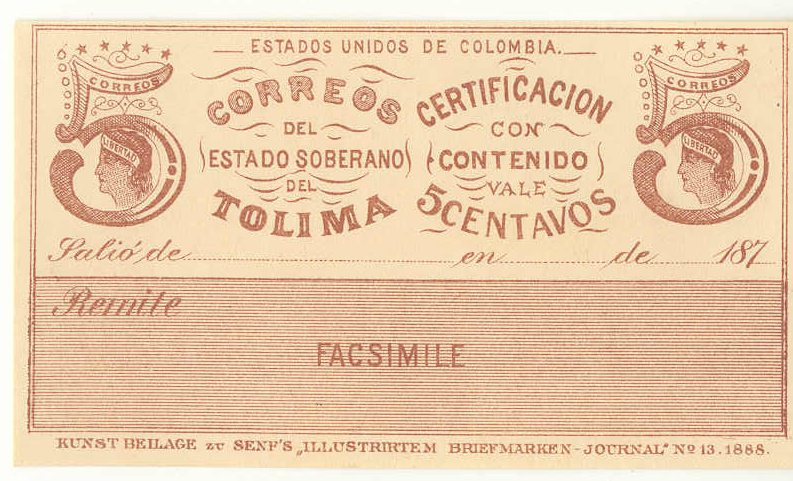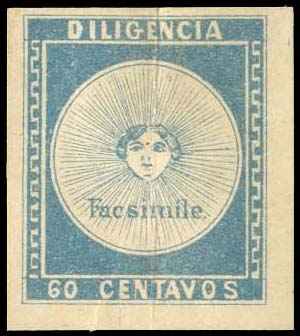
Note: on my website many of the
pictures can not be seen! They are of course present in the cd's;
contact me if you want to purchase them: evert@klaseboer.com.
The Senf brothers (Emil Louis Richard and Wilhelm August Louis) printed a journal, the 'Illustrierten Briefmarken Journal', in Leipzig, Germany. They added 'Kunst-Beigaben' or 'art supplements' to each issue of his journal. These forgeries always had the overprint 'Facsimile' or 'FACSIMILE', 'Falsch' or 'FALSCH' included in the design. These forgeries also seem to have been sold directly to collectors (most of them with similar overprints indicating they were forgeries). The period in which they were produced was from about 1870 to 1890.
On http://www.klassische-briefmarken.de/ibj.htm
the folllowing text can be found:
"Das Illustrierte Briefmarken - Journal ( abgekürzt
I-B-J ) erschien von 1874 an unter dem Dache einer der größten
Briefmarkenhandlungen Deutschlands , der Fa. Gebr. Senf in
Leipzig - welche übrigens auch die berühmten Schaubekalben
heraus gaben - Die Auflage, Anfangs gering wuchs um die
Jahrhundertwende 1900 auf über 20.000 Exemplare und war damit
die größte Fachzeitschrift im Bereich der Philatelie in
Deutschland. Sie erschien bis zum zweiten Weltkrieg."
From the above text we can deduce that the first 'Illustrirtem Briefmarken Journal' (where 'Illustrirtem' is sometimes spelled as 'Illustrierte' or 'Illustriertes') appeared first in 1874. The number of magazines printed was limited at first, but rose to over 20,000 around 1900. From this we would deduce that the number of facsimiles distributed must have been considerably less than 20,000.... However, the book 'Philatelic Forgers, their Lives and Works' by V.E.Tyler states that the first facsimiles appeared in 1884 as art supplements. Tyler also says: 'The facsimiles proved, at first, to be very popular, and the Senfs also prepared and sold large quantities of them directly to collectors, thereby becoming the greatest producers of postage stamp facsimiles in the western world'.
Besides a journal, Senf also issued stamp catalogues.
Example of a forgery of Surinam:

Often genuine stamps were also given ('Gratis-Beigabe') with this journal.
A total of 90 stamps (or sometimes sheets) and 4 postal stationary were given with the journal (source: 'Philatelic Forgers Their Lives and Works' by Varro E. Tyler). Other examples of his 'supplements' that I know of:
1884:
1 January Bolivar 10 Pesos
15 June 1884 Philippines 1854, 1 R blue
No 20 (15 October 1884) Philippines 1854, 10 c red
1885:
No 21: (5 November 1885) Philippines 1863, 1 Real red
1886:
No 1: Mulready envelope of Great Britain, 2 p blue
No 2: (22 January 1886) Philippines 1855, 5 Cuartos red.
No 5 (5 March 1886): Russian post in Turkey 1865 10 c
issue (together with a 'genuine' Helgoland 1 f stamp)
No 20 (16 October 1886): Spain 1853, 2 r red
No 24 (18 December 1886): Neuchatel cantonal issue 5 c black and
red
1887:
No 14 (16 July 1887): Parma 1854, 5 c yellow
No 16 (20th August 1887): Greece, Postage due stamp of 1875, 1 D
black and green
No 19 (1st October 1887): Bolivar 1863: 10 c green
No 23 (3 December 1887): Finland, envelope-cut of 1845, 20 k red
No 24 (17 December 1887): Russian post office in the Levant,
1863, 6 k blue
1888:
No 1: Guatemala's first postcard + Tolima 50 c postal
stationery
No 9 (5 May 1888): Guatemala 1 Peso 1872 stamp.
No 13: Colombia Tolima, very large 'Certificacion con Contenido'
No 14 (21 July 1888): British Bechuanaland, 1888, 5 Pounds lilac
and black
No 23 Great Britain, reprint of a Mulready envelope, 1 p black
1889:
No 1: 12$ USA newspaper stamp + three Colombian postal
stationaries.
No 4 (16 February 1889): Surinam, King William, 2G50c green and
orange
No 10 (18 Mai 1889): Curacao, King William, 2G50 c brown and
violet
No 12 (15 June 1889): Bhopal, 1888, sheet with 1/4 a green
(reduced to 2/3 of its size)
No 13 (6 July 1889): Russia, 1889, 1 R brown and orange
No 16 (17 August 1889) St.Vincent 5 Shillings 1880 stamp.
No 21 (2 November 1889): Salvador 1879 5 centavos; sheetlet
showing all types
Senf also made a forgery of the 2 p Mulready envelope of Great Britain.
Examples of Senf forgeries:

(Curacao, 2G50c, with overprint
'FACSIMILE' in violet)
San Salvador: a whole sheet of 5 c blue stamps of the 1879 issue; all types are reproduced. The individual stamps have a red overprint 'Facsimile'. On top of the sheet is written 'Kunstbeigabe':

(El Salvador, with red overprint 'Facsimile')
The Tolima postal stationery forgery made by Senf:

Senf also made a forgery of the three-coloured 10 c and 50 c value postal stationery of Tolima (the forgeries have inscription 'FACSIMILE' twice in the 'Remite' section at the bottom.

I've seen the 50 c value with additional inscription 'KUNST BEILAGE ZU SENF'S "ILLUSTRIERTEM BRIEFMARKEN- JOURNAL" No 1 1888'.

A similar item from Colombia with inscription 'FACSIMILE',
probably also made by Senf

An advertisement for these 'Facsimiles' from Senf, where a set of
10 facsimiles are offered for a price of 2 Mark. It includes the
25 c and 50 c 1865 issue, the 50 c 1867 issue, the 50 c 1870
issue for Colombia. Also the 5 c, 10 c
and 50 c of the 1879 issue and the 5 c, 10 c, and 50 c of the
1886 issues of Tolima were included.
The inscription of the above card is:
" Angeregt durch den ausserordentlichen Beifall, den unsere verschiedenen
Facsimiles schwer zu erlangender, bezw. seltener und daher sehr teurer Postwert-
zeichen, besonders die der Amerikanischer Zeitungsmarken in allen Sammlerkreisen
gefunden haben, bringen wir heute eine derartige Serie, die sicherlich die gleich
gunstige Aufnahme finden wird.
Es sind dies
Facsimiles
der
in fast allen Sammlungen ihrer Seltenheit wegen fehlenden, (in Originalen mit
120 Mark bewerteten)
Columbia- und Tolima-
Geldbrief-Vignetten.
der Satz von 10 Stuck besteht aus folgenden Werten:
Columbia
1865. 25 Centavos braun, gelb, blau u. rot
50 "
1867. 50 Centavos schwarz, gelb, blau u. rot
1870. 50 Centavos "
Tolima
1879. 5 Centavos braun
10 " schwarz u. irisfarben
50 " " "
1886. 5 Cts. gelb, 10 Cts. blau u. 50 Cts. rot.
die wir zum Preise von
2 Mark fur den Satz
allen Sammlern gegen vorherige frankierte Einsendung des Betrages ebenfalss
portofrei zu Verfugung stellen.
Auch diese "Facsimiles" sind in gewohnt vorzuglicher Weise ausgefuhtt -
wir gaben bereits im Jahrganga 1888 des "Illustr. Briefm.-Journals mit der
Kunstbeigabe zu No.1 eine Probe davon -; sie durften vielen Sammlern als
billger Ersatz fur die so schwer erhatlbaren Originale hochwillkommen sein.
Wir sehen recht zahlreichen Bestellungen, die sofortige Erledigung finden
werden, entgegen und zeichnen
hochachtend
Gebruder Senf in Leipzig."

First postcard of Guatamala given with No 1 of 1888 of the
'Illustrirtem Briefmarken - Journal'
A forgery of the 1 D postage due stamp of Greece:

(The perforation is printed, with overprint 'Facsimile')
A square cut forgery of the 1845 envelope of Finland:

(Overprinted 'Facsimile')
Senf also made a forgery of the imperforate 1 R value of Russia of 1889. This forgery was distributed with No 13 (6 July 1889, thus long before the imperforate stamps of 1915 were issued), the text 'Falsch.' is printed in orange on top of the stamp:

Forgery of Russian Levant:

(Overprinted 'FACSIMILE.')
A Parma 5 c yellow 1854 forgery:
Bolivar 1863 10 c green forgery:
All 8 types of the Corrientes stamps (with red 'FACSIMILE' overprint):

I've also seen another Corrientes forgery made by Senf, apparently not any of the above types, without the 'FACSIMILE' overprint. He also seems to have forged the 1 r black on blue stamp of 1856.

Corrientes Senf forgery with 'FALSCH' written in the blue
background at the bottom.
Naples Trinacria forgery (1/2 T blue, produced in 1884) and a forgery of the 1/2 T cross :


(With overprint 'FACSIMILE.' and 'FALSCH')
Senf forgeries of the Papal States:

(1 Sc Senf forgery with oveprint 'FALSCH.')
Senf made forgeries of the values 1/2 , 1 b, 2 b, 3 b, 4 b, 5 b, 7 b (two subtypes), 8 b, 1 Sc, 3 c, 5 c, 10 c, 20 c, 40 c and 80 c of the Papal States.
Persia (Iran):
In the above two stamps of Persia the inscription 'FALSCH' is added in the bottom part of the stamp. The second mage was obtained with permission from the Forgeries idenfication site of Bill Claghorn.
A Senf forgery of Mexico:
The Senf brothers also made forgeries of the newspaper stamps of the United States. The word 'FALSCH' (=forged in German) is incorporated in the design. It seems that no 1 c was forged, but instead an advertisement label was made. Four of these stamps were distributed in the 'Illustrierten Briefmarken Journal' (the Dollar values), other values were sold to collectors (another 23 stamps; 19 of the 1875 issue and 3 of the 1865 issue). These forgeries can be found in the cd containing Volume 1.
Senf forgeries of Peru:
Senf forgeries of Colombia:


Columbia 1879 25 c green (overprinted 'FACSIMILE'), in the second
image somebody has tried to removed this overprint and has
applied a forged cancel.
Forgery of the first issue of Uruguay (60 c) with 'Facsimile.' incorporated in the design:

('Diligencia' forgery of Uruguay)


Left image obtained from http://nigelgooding.co.uk/

Russian Levant (Russian post offices in Turkey) 1865 10 pa brown
and blue ('FALSCH' written at the bottom)

Spain 1853 1 c brown 'CORREO INTERIOR'
arms issue (with 'FALSCH' overprint)

Modena 'BG CEN 9' black on red ('FALSCH' written in white on the
background at the bottom of the stamp)
Afghanistan 1871/72 1/2 r brown, 1 r brown (overprint 'FACSIMILE')



The first forgery is made by Senf, I presume the other two were
also made by him.
Bolivar 5 P and 10 P 1882 issues:
Possible Senf forgeries of Guatemala?

(This forgery has the word 'FACSIMILE' incorporated in the design
below the shield)
In the next forgeries, the word 'FACSIMILE' of the above forgery, has been coloured in (but is still faintly visible):


Basel Dove 1845 (overprint 'FACSIMILE'). The left 'FACSIMILE'
overprint is partly erased, when trying to creat a 'genuine'
stamp.

Neuchatel Cantonal issue (Switzerland) 5 c black and red forgery
with blue 'FALSCH' overprint.


Senf forgeries of the 10 Cs and 1 R values (1 R value obtained
thanks to Nigel Gooding). These forgeries do not have any
indication that they are forgeries.
Other Senf forgeries, of which I don't have
pictures yet:
Belgian Congo 1886 5 F violet (with 'Falsch' overprint, also
without this overprint?)
Columbia 1861 5 c yellow (overprinted 'Falsch')
Columbia 1886 5 P brown (with overprint 'FALSCH')
Russia, postal stationery (stamped envelope) of 1845 5 k blue
(with overprint 'FACSIMILE'?)
Spain 1853 2 r red Queen Isabella (with overprint 'FALSCH')
If anybody possesses pictures of any of these forgeries, please contact me!
More Senf forgeries can be found on the cd with Volume 1.

Postal forgery of the 6 c value of the 1989 issue of Cuba . The inscription 'CUBA - 1898 y 99' is
very badly done when compared to a genuine stamp. Image obtained
from: http://www.philat.com/FIL/1890-1898/Cuba--King%20Alfonso%20XIII%20Issues%201898--6%20cents--Postal%20Forgery.pdf

This postal forgery was pasted on a letter, together with two
genuine stamps (2 c and 3 c) and adressed to Gebruder Senf in
Leipzig (picture also obtained from the above mentioned website).
Therefore I don't know if this forgery was made with some
philatelic intention. The fact that it was send to Senf makes it
at least 'suspicious'.
Stamp forgeries - Timbres-poste, faux - Briefmarken Fälschungen